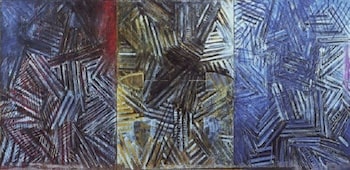Weeping Women, 1975 by Jasper Johns

Weeping Women (1975), a triptych painted in subdued primary colors, is, as Rosalind Krauss has written, drawn from Picasso's paintings of
nudes in the proto-Cubist period of 1907-9. If one posits that the three women exist in Johns's canvases, the figures are suggested by the insistent long strokes and by the fading of the strokes toward the
edges of the panels. They obey that characteristic compositional device of Cubist painting, constructed from the center and opening out on either side of a notional spine drawn down the canvas. Picasso's
images are double-hatched, with a secondary thinner hatching used to delineate forms. Johns does this too, but his hatching also obeys his own rules.
It is interesting to apply Daniel Henry Kahnweiler's description of Picasso's second phase of work on the Demoiselles d'Avignon
to this painting by Johns; he wrote: ". . . the color is not spread smoothly over the canvas, but dragged in parallel strokes aiming at creating shape, not by light and shade . . . but by
drawing, by the direction of the actual strokes of paint. Artists had imitated Paul Cezanne's subjects and copied the appearance of his pictures,
without comprehending their whys and wherefores. Now at last he was understood."
Johns has combined several other aspects of Picasso's work: the title Weeping Woman did not appear until the 1930s, while the
impressions of the iron are strongly reminiscent of the collaged breasts in the Femme en chemise assise dans un fauteuil of 1913, owned by Johns's friends and collectors Mr. and Mrs.
Victor Ganz. The right-hand panel introduces the paintbrush-can mark as breasts and qualifies the surface. Johns used large strokes in his Weeping Women, and, perhaps because of the
subject matter, did not seem preoccupied with the inversion and mirroring that abound in the other works of this date.
